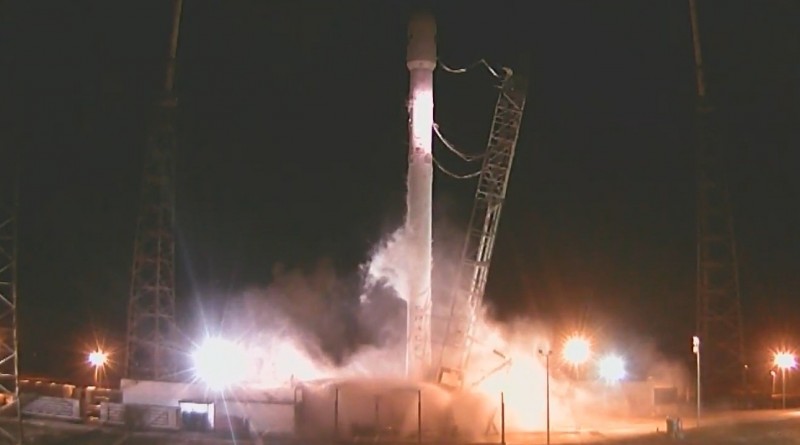Falcon 9 Rocket completes Static Fire Test for next High-Energy Satellite Delivery Mission
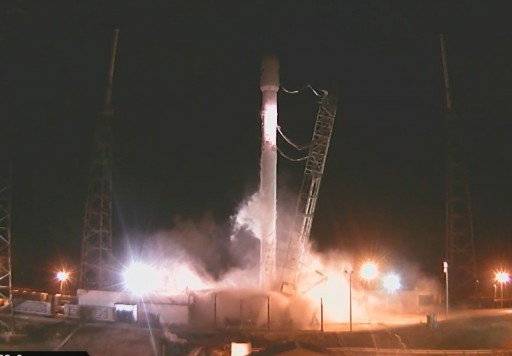
A SpaceX Falcon 9 rocket was fired up Tuesday night at its Cape Canaveral Launch Pad as part of its Static Fire Test on a path to liftoff on Thursday with the Thaicom-8 communications satellite. Pending reviews of the Static Fire, SpaceX is aiming to launch the Falcon 9 during a two-hour window on Thursday, opening at 21:40 UTC.
SpaceX is accelerating the company’s launch pace with this launch planned just 20 days after the last Falcon 9 launch from Florida that successfully lifted the JCSat-14 satellite to Geostationary Transfer Orbit and achieved the first successful high-energy return of the rocket’s first stage to a precision landing atop the Autonomous Spaceport Drone Ship. The May 6 mission raised SpaceX’s inventory of returned cores to three, currently crowding up the Horizontal Integration Facility at Launch Complex 39A at the Kennedy Space Center, but the three cores will soon part ways.
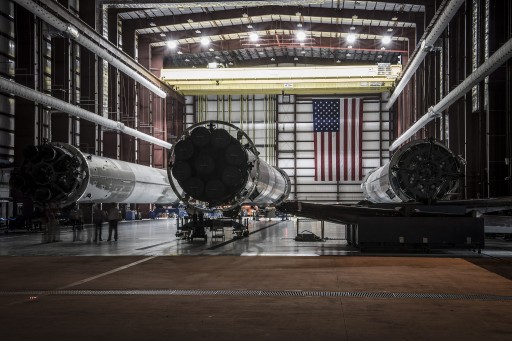
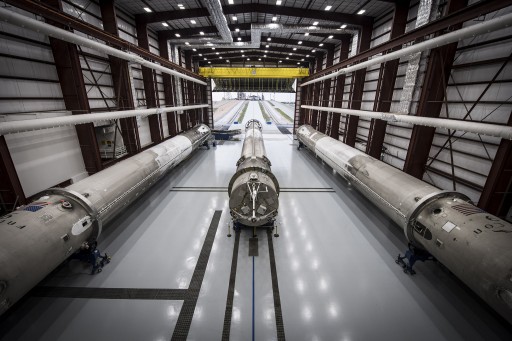
The F9-020 stage from the first land-based landing in December’s Orbcomm G2 mission will be put on display at SpaceX headquarters in Hawthorne, California while the future looks more exciting for the other two stages.
F9-023, the first booster to master a landing on the Drone Ship, is looking forward to a testing campaign ahead of a re-flight in an operational mission later this year. The F9-024 core that was recovered on the previous mission will travel to McGregor where it will undergo component testing and Static Fire tests as engineers assess the condition of the vehicle after a particularly challenging re-entry created by tight margins on the high-energy GTO flight.
For the Thaicom-8 mission, margins for the first stage return are likely a little more relaxed, however, this mission is understood to be a Supersynchronous delivery, requiring Falcon 9 to boost the orbit’s apogee to around 80,000 – 90,000 Kilometers.
The Autonomous Spaceport Drone Ship ‘Of Course I Still Love You’ will be located 680 Kilometers from Cape Canaveral, slightly further than for the JCSat-14 mission which confirms that the flight does not have enough propellant reserves for a braking/boost back of the first stage. Margins may allow for a longer re-entry burn to slow the vehicle down and make the entry environment not as challenging. Whether the ASDS landing will again feature the aggressive three-engine landing burn has not yet been specified.
Stepping up the launch pace, SpaceX aims to fly out a full manifest this year as a long line of missions has built up after Falcon 9 had to stand down for half a year after the June 2015 launch failure. Launches from Cape Canaveral are likely to occur at a three-week cadence and SpaceX’s West Coast pad at Vandenberg will see action on multiple occasions. Falcon Heavy is also still on the books for 2016, though its maiden launch has already slipped from an original summer target to ‘No Earlier Than’ December.
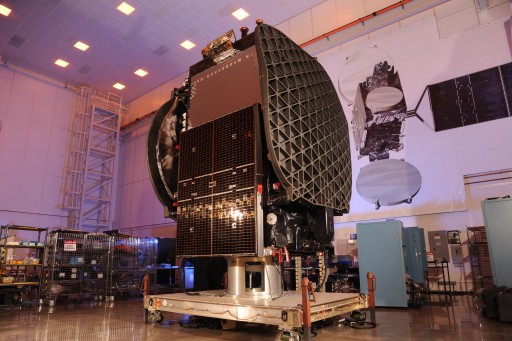
The 3,100-Kilogram Thaicom-8 satellite was delivered to Cape Canaveral from manufacturer Orbital ATK in late April to complete fueling for flight and undergo final inspections before meeting its Falcon 9 rocket. This is the second collaboration between satellite operator Thaicom PLC, satellite builder Orbital ATK and launch provider SpaceX after the successful launch of Thaicom 6 in January 2014.
The Falcon 9 rocket was transferred to the hangar at Space Launch Complex 40 very shortly after the launch of JCSat-14 to complete assembly and integration with the payload. The assembled rocket was moved to the launch pad around 5 p.m. local time on Tuesday in preparation for the standard Static Fire test that had been a part of every SpaceX launch campaign, starting with the early Falcon 1 flights.
Raised to a vertical position, Falcon 9 was hooked up to ground systems and a series of tests were conducted before the vehicle headed into its 35-minute Automated Countdown Sequence. Over 500 metric-tons of Liquid Oxygen and Rocket Propellant 1 were pumped into the two-stage rocket in less than 30 minutes along with Helium tank pressurant and Nitrogen Attitude Control System Propellant – putting all high and low-pressure systems of the rocket to the test.
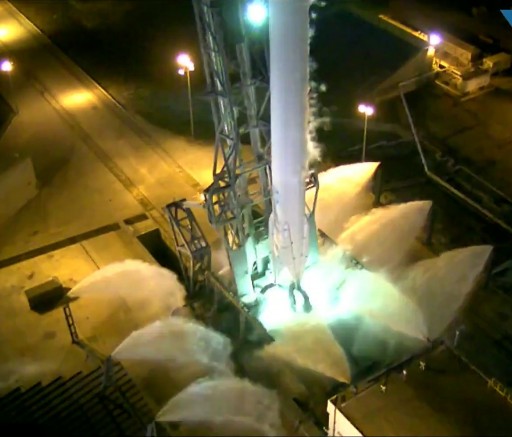
The expedited tanking sequence is a requirement arising from the use of sub-cooled LOX and chilled RP-1 on the Falcon 9 Full-Thrust rocket. SpaceX perfected the sequence over the first four launches of Falcon 9 FT and can now reliably fill the vehicle with only two minutes between the completion of tanking and T-0.
Over the final minutes of the countdown, Falcon 9 chills down its nine Merlin 1D engines, switches to battery power, pressurizes its tanks and starts up its flight computers.
Standing 70 meters tall atop its launch pad with the Strongback structure retracted, Falcon 9 ignited its nine Merlin 1D engines and flames erupted from the base of the rocket for a brief build-up of thrust on all the engines. After firing for around three seconds, Falcon 9 completed a controlled shutdown and went through initial safing while the launch team checked whether the full burn duration was achieved and the necessary data was gathered.
A thorough review of performance data from the Static Fire Test will be made on Wednesday leading into the Launch Readiness Review that will provide the formal clearance for a launch attempt on Thursday. Weather for Thursday’s launch attempt is expected to be very good with a 90% chance of acceptable conditions, liftoff winds being the only slight concern. In case of a 24-hour delay to Friday, meteorologists are predicting a 30% chance of weather rule violations due to a risk of cumulus clouds and strong ground winds.
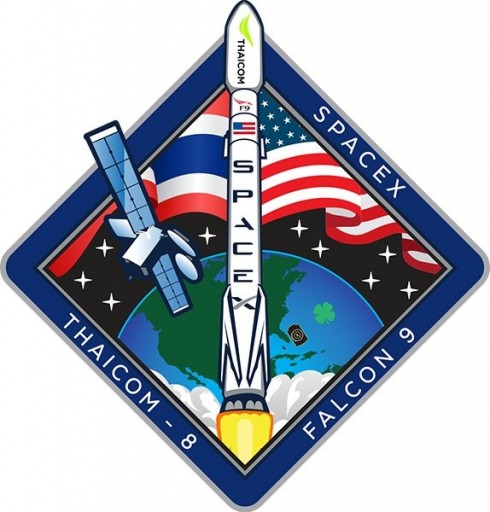
An area of disturbed weather is forming east of the Bahamas in the next few days and will move towards the Carolinas, staying east of Florida. Although the weather stays away from the spaceport, the difference in pressure between the system and a high-pressure ridge over Florida will bring strong winds. Towards the end of the week, the system will start bringing moisture to Florida, de-stabilizing the atmosphere and decreasing the odds for favorable launch weather in case the mission has to shift to the right.
Falcon 9 is again set to take the standard route to GTO, flying east-south-east after lifting off from Space Launch Complex 40. The first stage will be in action for just over two and a half minutes before the MVac engine of the second stage takes over to finish lifting the stack into a slightly elliptical parking orbit. After separation, the first stage will go through the motions as part of its return journey, aiming for another high-energy approach to the Autonomous Spaceport Drone Ship – ideally coming to rest on its four landing legs in the center of the steel deck eight and a half minutes after launch.
The second stage will complete a brief coast phase to continue south-east so that the second burn can center the equator to place the high-point of the insertion orbit above the equator – standard practice for GTO missions. Firing up its MVac engine for the second time, the upper stage will be tasked with lifting the satellite into a highly elliptical transfer orbit into which it will be released around half an hour after launch.
The Thaicom 8 satellite, featuring an all Ku-Band payload, will operate from 78.5° East in Geostationary Orbit delivering broadcasting services to three coverage zones – East Africa, India and surrounding areas, and Thailand and neighboring countries. Thaicom 8 will be co-located with the Thaicom 5 and 6 satellites in operation since 2006 and 2014.

